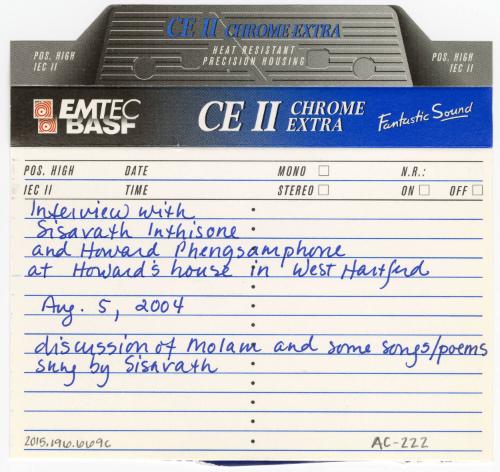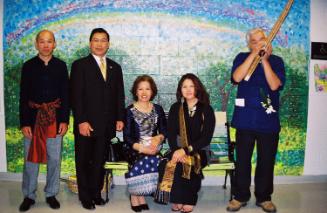Interview with Sisivath Inthisone & Howard Phengsomphone
IntervieweeInterview with
Sisivath Inthisone
(Laotian)
IntervieweeInterview with
Howard Phengsomphone
(Laotian)
InterviewerInterviewed by
Lynne Williamson
Date2004 August 5
Mediumreformatted digital file from audio cassette
DimensionsDuration (side 1): 44 Minutes, 58 Seconds
Duration (side 2): 23 Minutes, 55 Seconds
Duration (total runtime): 1 Hours, 8 Minutes, 59 Seconds
ClassificationsInformation Artifacts
Credit LineConnecticut Cultural Heritage Arts Program collections
CopyrightIn Copyright
Object number2015.196.669a-d
DescriptionAudio cassette tape of an interview with Sisivath Inthisone and Howard Phengsomphone on August 5, 2004. They were interviewed by Lynne Williamson at Howard Phengsomphone's house in West Hartford, Connecticut. They discuss molam, a traditional storytelling musical form in Laos. Sisivath Inthisone sings some songs and poems.
NotesBiographical Note: Houmpheng (Howard) Phengsomphone retired from a long career as a counselor and administrator of several federal and state substance abuse and violence prevention projects in Rhode Island and Connecticut. In 1999 U.S. Department of Health selected his program as one of the best refugee services for youth and families. He has spoken at national conferences and universities on his work with gangs and violence prevention. A survivor of imprisonment by the Communist regime in Laos, Howard’s volunteer community involvement has been his way of supporting Lao in America who still struggle with emotional and cultural losses from the war and its aftermath. He served on the Rhode Island Coalition for Affirmative Action, the Southeast Asian Advisory Council for Parents and Schools (RI), the Providence Mayor’s Council on Human Relations, and the Governor’s (RI) Juvenile Justice Commission. He has been a Board Member of the Lao Association of CT since its inception, and was a founder, along with his wife Sue (Sisimphone), and teacher of culture and history at Lao Saturday School in New Britain for years beginning in 1994. Howard has spearheaded the collaborative development of expanded cultural heritage opportunities for Lao teens in Connecticut, leading to a partnership with CCHAP and Cambodian, Hmong, and Lao cultural leaders to offer afterschool programs, funded by the National Endowment for the Arts. The longtime Executive Director of the Lao Association of Connecticut, he continues to work in the area of culture, health, history, and community service for the Lao community.Biographical Note: Sisivath Inthisone learned to perform as a Molam, a singer of the traditional improvisational sung poetry of Laos called Lam, a rhythmic extemporaneous sung poetry , as a boy living in a rural province in central Laos. He enjoyed singing, and learned the skilled wordplay from an older friend who encouraged and instructed him. Later Sisivath deepened his interest while in high school, also continuing “to lam” orally. After resettling in the US, he organized a band to play at community festivals and parties, and is in demand here because there are few singers who can evoke the traditional content (courtship, village life, politics) and song style as a Molam. Lam remains very popular as a sort of Lao hip-hop, rhythmic, urgent, funny, vivid, competitive, and communal. Sisavath has served as President and Treasurer of the Lao Buddhist Temple in New Britain CT, and taught Lao language and arts at Lao Saturday School since 1997 and in the Southeast Asian After School Program funded by the National Endowment for the Arts and coordinated by CCHAP. He shared musical skills with khene player Boualy Ratsombath in Year 10 of the Southern New England Traditional Arts Apprenticeship Program. He was a machinist at Westinghouse Electric Co. for many years.
Subject Note: Connecticut was a major resettlement site for Southeast Asians in the 1980's. The Lao population numbers over 3000, living primarily in urban areas such as New Britain, Bridgeport, East Hartford, and Danbury and for a time in the 1990s-2007, in rural eastern Connecticut. While many Lao have found employment in factories, service industries, farming, and trades such as food, they continue to face barriers of language, lack of education, and lower income levels, all against a common backdrop of serious emotional wounds from the Viet Nam War era. Youth aged 10 - 19 years old have been by far the largest age group among Connecticut Southeast Asians. Maintaining young peoples’ awareness of heritage, culture, values, and language is a major goal of Lao leaders and parents. The Lao community sustains its traditional cultural practices in several ways. Several temples around the state provide gathering places where Buddhist monks and nuns offer spiritual services and cultural festivals. The largest temple is in Morris, where the resident monk Khoutavong has created exquisite Buddhist statues and traditional architecture with symbolic carvings, ornamentation, and shrines. Dancer and educator Manola Sidara developed and has directed Lao Narthasin, a traditional dance group now in its third generation of dancers. They perform classical, folk, and social dances that highlight cultural values such as respectful behavior and appreciation for elders. Manola also specializes in creating ceremonial decorations that express wellness, spirituality, and bonding during community celebrations, and she also promotes health and healing through her work as a master chef. The Lao Association of Connecticut formed in 1980 to unite the community and assist in economic development, cultural preservation, education, and health. For many years LAC offered classes in language, history, food and medicine, verbal arts, traditional music, and singing at Jefferson School in New Britain, and the group organizes several heritage festivals each year at the Morris temple that are attended by hundreds of Lao people. Other Lao community groups around the state also develop and present spiritual and cultural programs as well as health initiatives.
Additional audio, video, and photographic materials exist in the archive relating to this community and its artists.
Cataloging Note: This project was made possible in part by the Institute of Museum and Library Services MA-245929-OMS-20.
Status
Not on viewHoward Phengsomphone
2007 May 12









